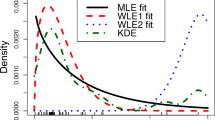Abstract
The performance of computationally inexpensive model selection criteria in the context of tree-structured subgroup analysis is investigated. It is shown through simulation that no single model selection criterion exhibits a uniformly superior performance over a wide range of scenarios. Therefore, a two-stage approach for model selection is proposed and shown to perform satisfactorily. Applied example of subgroup analysis is presented. Problems associated with tree-structured subgroup analysis are discussed and practical solutions are suggested.
Similar content being viewed by others
References
Akaike H. 1974. A new look at the statistical model identification. IEEE Transactions on Automatic Control AC-19: 716–723.
Breiman L., Friedman J.H., Olshen R.A. and Stone C.J. 1984. Classification and Regression Trees. Wadsworth, Belmont, CA.
Bulpitt C.J. 1988. Subgroup analysis. Lancet 2: 31–34.
Ciampi A., Lou Z., Lin Q. and Negassa A. 1991. Recursive partition and amalgamation with the exponential family: Theory and application. Applied Stochastic Models and Data Analysis 7: 121–137.
Ciampi A. 1991. Generalized regression trees. Computational Statistic and Data Analysis 12: 57–78.
Ciampi A., Negassa A. and Lou Z. 1995. Tree-structured prediction for censored survival data and the cox model. Journal of Clinical Epidemiology 48: 675–689.
Cox D.R. 1972. Regression models and life tables (with discussion). Journal of the Royal Statistical Society B 34: 187–220.
Davis R.B. and Anderson J.R. 1989. Exponential survival trees. Statistics in Medicine 8: 947–961.
Efron B. 1983. Estimating the error rate of a prediction rule: Improvement on cross-validation. Journal of the American Statistical Association 78: 316–331.
Gail M. and Simon R. 1985. Testing for qualitative interactions between treatment effects and patient subsets. Biometrics 41: 361–372.
Kalbfleisch J.D. and Prentice R.L. 1980. The Statistical Analysis of Failure Time Data. J. Wiley and Sons, New York.
Krzanowski W.J. and Lai Y.T. 1988. A criterion for determining the number of groups in a data set using sum-of-squares clustering. Biometrics 44: 23–34.
LeBlanc M. and Crowley J. 1992. Relative risk tree for survival data. Biometrics 48: 411–425.
LeBlanc M. and Crowley J. 1993. Survival tree by goodness of split. Journal of the American Statistical Association 88: 457–467.
Negassa A., Ciampi A., Abrahamowicz M., Shapiro S. and Boivin J.-F. 2000. Tree-structured prognostic classification for censored survival data: Validation of computationally inexpensive model selection criteria. Journal of Statistical Computation and Simulation 67: 289–318.
Schmoor C., Ulm K. and Schumacher. 1993. Comparison of the cox model and the regression tree procedure in analysing a randomized clinical trial. Statistics in Medicine 12: 2351– 2366.
Segal R.M. 1988. Regression tree for censored data. Biometrics 44: 35–47.
Yusuf S., Wittes J., Probstfield J. and Tyroler H.A. 1991. Analysis and interpretation of treatment effects in subgroups of patients in randomized clinical trials. JAMA 266: 93–98.
Zhang H. and Singer B. 1999. Recursive Partitioning in the Health Sciences. Springer-Verlag, New York.
Author information
Authors and Affiliations
Corresponding author
Rights and permissions
About this article
Cite this article
Negassa, A., Ciampi, A., Abrahamowicz, M. et al. Tree-structured subgroup analysis for censored survival data: Validation of computationally inexpensive model selection criteria. Stat Comput 15, 231–239 (2005). https://doi.org/10.1007/s11222-005-1311-z
Received:
Accepted:
Issue Date:
DOI: https://doi.org/10.1007/s11222-005-1311-z




